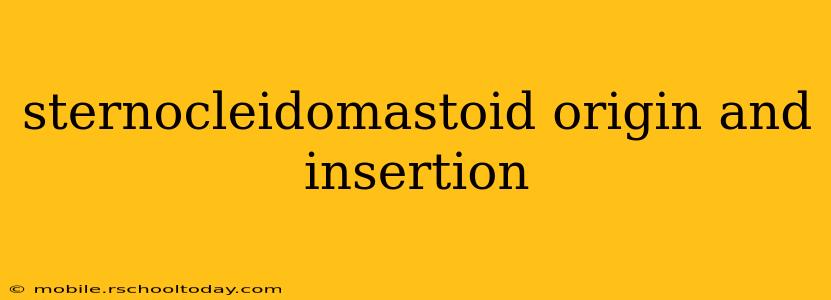The sternocleidomastoid (SCM) muscle is a prominent muscle in the neck, easily visible beneath the skin. Its distinctive shape and location contribute significantly to neck movement and head posture. Understanding its origin, insertion, and actions is crucial for healthcare professionals, athletes, and anyone interested in human anatomy and biomechanics. This detailed exploration will cover its anatomical features, functional roles, and clinical relevance.
Origin of the Sternocleidomastoid Muscle
The sternocleidomastoid muscle has a dual origin, stemming from two distinct bony landmarks:
-
Sternal Head: This originates from the anterior surface of the manubrium of the sternum, the uppermost part of the breastbone.
-
Clavicular Head: This originates from the superior surface of the medial third of the clavicle (collarbone).
These two heads converge as they ascend towards the mastoid process.
Insertion of the Sternocleidomastoid Muscle
The sternocleidomastoid muscle inserts into the mastoid process of the temporal bone, a bony projection located behind the ear, and the lateral half of the superior nuchal line of the occipital bone, at the base of the skull.
Actions of the Sternocleidomastoid Muscle
The actions of the SCM are multifaceted and depend on whether it acts unilaterally (one side) or bilaterally (both sides).
Unilateral Contraction:
- Rotation: Contraction of the SCM on one side rotates the head towards the opposite side. For example, contracting the right SCM rotates the head to the left.
- Lateral Flexion: Simultaneously, it laterally flexes (bends) the neck towards the same side as the contracting muscle. So, the right SCM laterally flexes the neck to the right.
Bilateral Contraction:
- Flexion: When both SCM muscles contract simultaneously, they flex the neck, bringing the chin towards the chest. This action is often seen when performing neck exercises or during forceful exhalation.
- Extension (from a flexed position): From a flexed position, bilateral SCM contraction can assist in bringing the head back to a neutral position.
Clinical Significance of the Sternocleidomastoid Muscle
Understanding the SCM's function is crucial in diagnosing and treating various clinical conditions:
-
Torticollis (Wry Neck): This condition involves a shortening or spasm of the SCM, resulting in a tilted head and rotated neck. It can be congenital (present at birth) or acquired.
-
Cervicalgia (Neck Pain): SCM involvement can contribute significantly to neck pain and stiffness, often related to poor posture, muscle strain, or whiplash injuries.
-
Headaches: Tension headaches and migraines can be associated with SCM tightness and trigger points.
-
Difficulty Swallowing (Dysphagia): In severe cases, SCM dysfunction can indirectly affect swallowing by impacting head and neck positioning.
-
Surgical Procedures: Surgeons must be acutely aware of the SCM's location during procedures in the neck and head region.
-
Palpating the SCM: Clinicians often palpate the SCM to assess muscle tone, tenderness, and the presence of trigger points. This assists in diagnosing and managing neck pain and related conditions.
Conclusion
The sternocleidomastoid muscle is a key player in head and neck movement, and its dual origin and insertion points allow for a wide range of actions. Understanding its anatomy, function, and clinical relevance is crucial for healthcare providers, physical therapists, and anyone interested in human movement and health. By appreciating the complex role of the SCM, we gain a deeper insight into the intricate mechanics of the human body and the potential for dysfunction that can significantly impact an individual’s health and well-being.
